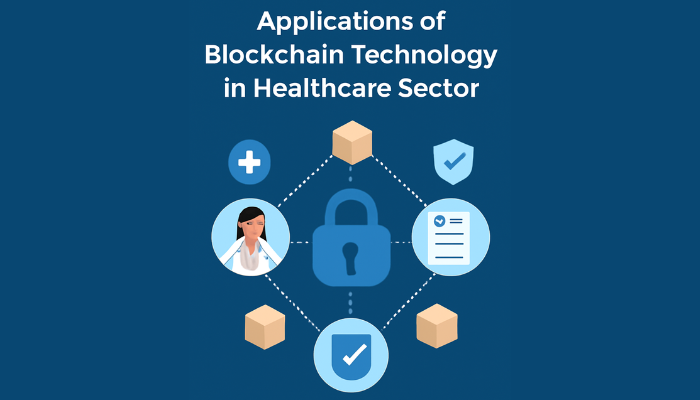If you’ve ever dealt with messy patient records, slow data sharing, or worries about privacy, you’re not alone. Healthcare data is complicated and sensitive, and making it both safe and accessible can feel like a tough balancing act.
Blockchain offers a new way to handle this. Instead of relying on one central system, it stores information across multiple locations, making it very hard to change or tamper with. This means patient records stay accurate and up-to-date, and only the right people can access them.
It also helps track important processes like billing or medication delivery with clear records everyone can trust.
Simply put, blockchain can ease many of the data challenges you face, helping your operations run smoother and your patients feel more confident.
What You’ll Learn in This Blog:
- A simple explanation of how blockchain works in healthcare
- The main challenges healthcare data currently faces
- Ways blockchain helps fix those problems
- Real-world applications of blockchain in healthcare
By the end, you’ll see why blockchain is a tool that can make healthcare data safer, faster, and more reliable.
Let’s Start!
How Blockchain Works in Healthcare
At its core, blockchain is a way to record and share information securely. Instead of storing data in one central place, blockchain keeps copies of the data across many computers. Each piece of information is grouped into a “block” and linked to the previous one, creating a chain that’s very hard to change without everyone knowing.
In healthcare, this means patient records, billing info, and other data can be stored safely and shared only with people who have permission. Every time data is added or changed, it’s recorded in a way that can’t be altered later. This helps build trust and transparency among patients, doctors, insurers, and other parties.
By making data more secure, reliable, and accessible, blockchain sets the stage for better healthcare services and smoother operations.
Managing healthcare data comes with its fair share of challenges. To understand why blockchain is such a promising solution, let’s first look at the common problems healthcare providers face every day.
Key Challenges in Healthcare Data Management
You carry a heavy responsibility every day managing large amounts of sensitive patient data. This isn’t just about technology, it’s about protecting your patients’ privacy and ensuring their safety. Yet, many of the systems you rely on are outdated or don’t communicate well, creating serious issues that slow down care and put patients at risk.
These challenges not only affect operational efficiency but also impact patient outcomes and trust in your organization. Understanding and addressing them is crucial to delivering the quality care your patients deserve.
Protecting Patient Privacy
Your patients trust you with some of their most personal information. When that data isn’t properly secured, that trust is broken, which can have lasting effects on your organization’s reputation and patient loyalty. Beyond reputational damage, data breaches come with hefty financial penalties and legal risks.
Cyberattacks targeting healthcare are growing in frequency and sophistication, making it essential for you to adopt stronger, proactive security measures that protect data without hindering access for authorized care providers.
Fragmented Patient Records
Chances are, your patient information is scattered across various systems—hospitals, clinics, labs, and specialist offices all maintain separate records. This fragmentation makes it difficult for you and your care teams to get a full and accurate view of a patient’s health history.
Without comprehensive data at your fingertips, clinical decisions can be delayed or less effective, leading to duplicated tests, medication errors, and missed diagnoses. Unifying patient records improves care coordination, reduces costs, and most importantly, saves lives.
Inefficient Billing and Claims Processing
Billing and insurance claims are often bogged down by manual processes, creating room for errors, delays, and even fraud. These inefficiencies not only drive up operational costs but also negatively impact your cash flow and patient satisfaction.
Slow reimbursements can strain your financial health, while confusing bills frustrate patients and reduce their trust in your services. Streamlining these processes through automation and transparent records can accelerate payments, reduce administrative overhead, and enhance patient experience.
Supply Chain Vulnerabilities
Your responsibility extends beyond patient data to ensuring that medicines and medical supplies are authentic and safe. The healthcare supply chain is complex, involving multiple parties and touchpoints. Without clear visibility, counterfeit or expired drugs can enter the system, jeopardizing patient safety and exposing your organization to legal risks. Enhanced tracking and traceability improve compliance, reduce waste, and build confidence in the treatments you provide.
Regulatory Compliance Challenges
Healthcare regulations like HIPAA and GDPR set high standards for data protection, requiring constant vigilance and investment. Failure to comply results in steep fines, legal action, and damage to your institution’s credibility. Compliance is not just a checkbox; it’s a continuous process demanding robust systems, regular audits, and staff training. Efficiently managing compliance helps you avoid risks and builds trust with patients and regulators alike.
Data Interoperability Issues
When your systems don’t communicate effectively, critical patient information can be delayed or lost. This not only hinders clinical workflows but also causes frustration among staff who must navigate multiple platforms to find data. Lack of interoperability slows decision-making and increases the chance of errors, affecting patient safety and operational efficiency. Seamless data exchange between systems enables faster diagnoses, coordinated care, and better resource utilization.
Maintaining Data Accuracy
Accurate, up-to-date patient records are essential for quality care. Errors or outdated information can lead to incorrect treatments, adverse drug interactions, and poor outcomes. Manual data entry is prone to mistakes and inconsistencies. Investing in reliable, automated data management reduces these risks and supports clinical confidence.
Scaling Digital Solutions
As your organization grows and adopts new technologies, scaling without compromising security or performance is critical. Integrating new tools should enhance workflows, not disrupt them. Planning for scalable, flexible systems enables your organization to adapt to future needs, improve patient services, and stay competitive in a rapidly evolving healthcare landscape.
How Blockchain Helps Solve Your Healthcare Challenges
Blockchain technology offers practical ways to tackle the issues you face every day in managing healthcare data and operations:
Strengthening Patient Data Security
With blockchain, patient information is encrypted and stored across multiple systems, making it extremely difficult for hackers to access or alter data. This decentralized security model reduces the risk of breaches and builds patient trust by ensuring their data is protected at all times.
Creating Unified Patient Records
Blockchain enables the creation of a single, tamper-proof record that all authorized providers can access. This means you and your care teams have a complete, up-to-date view of each patient’s history, improving diagnosis, reducing repeated tests, and enhancing overall care coordination.
Streamlining Billing and Claims
Smart contracts on the blockchain automate verification and payment processes, cutting down on errors, delays, and fraud. This increases operational efficiency, accelerates reimbursements, and improves financial transparency for both providers and patients.
Enhancing Supply Chain Transparency
Every step of a medication’s journey can be recorded on the blockchain, from manufacturing to delivery. This traceability ensures the authenticity of drugs, prevents counterfeit products, and helps you comply with regulations more easily.
Ensuring Regulatory Compliance
Blockchain’s immutable records provide clear, auditable trails for compliance with data protection laws like HIPAA and GDPR. Automated compliance checks reduce administrative burden and help you avoid costly fines.
Improving Data Interoperability
Because blockchain is a shared ledger accessible to all authorized parties, it naturally supports seamless data exchange across different systems. This interoperability streamlines workflows, reduces delays, and minimizes errors in patient care.
Maintaining Data Accuracy
Every update on the blockchain is time-stamped and verified, ensuring data integrity and reducing manual errors. This supports reliable patient records and more confident clinical decisions.
Supporting Scalable Digital Growth
Blockchain systems can be designed to scale with your organization’s needs, integrating smoothly with existing infrastructure and new technologies. This flexibility helps future-proof your operations and supports continuous innovation.
By addressing these key pain points, blockchain not only improves your daily operations but also elevates the quality of care you deliver and strengthens patient trust.
Ready to Improve Healthcare with Blockchain?
We help healthcare businesses integrate blockchain to secure data, improve care, and reduce fraud. See how we can help you get started.
Learn More About Our Blockchain Services
Now that we’ve explored the challenges healthcare organizations face and how blockchain can help, let’s look at some real-world examples showing these benefits in action.
Real-World Applications of Blockchain in Healthcare
Blockchain technology is already making a difference across various areas in healthcare. Here are some practical examples where it improves security, efficiency, and patient care
Blockchain technology is reshaping healthcare tech by providing secure, transparent, and efficient ways to manage data and processes. Here are key areas where blockchain is being applied to improve healthcare technology solutions:
Secure Electronic Health Records (EHRs)
Blockchain allows for the creation of decentralized and tamper-evident records of access and changes to electronic health records, ensuring data integrity and privacy while typically keeping sensitive patient data off-chain. Patients and providers can securely share and update medical information, ensuring data integrity and privacy. This eliminates reliance on centralized databases vulnerable to hacking and data loss.
Example: A hospital network uses blockchain to store and update patient records. Every time a doctor accesses a record, it’s logged on the blockchain, providing a transparent and immutable history. This ensures that sensitive medical data is always secure, and any tampering can be easily detected.
Data Sharing and Interoperability
Blockchain enables seamless and secure data exchange between different healthcare systems and providers. It creates a unified network where authorized parties can access accurate patient data in real time, improving collaboration and reducing data silos.
Example: Multiple healthcare providers, such as specialists and primary care doctors, use blockchain to share patient data in real-time. This allows them to coordinate treatment plans more effectively, ensuring all parties have the most up-to-date information, which leads to better patient care.
Identity and Access Management
Managing digital identities is critical in healthcare technology. Blockchain provides a reliable way to authenticate users and devices, granting access only to authorized personnel. This reduces risks related to unauthorized access and protects sensitive patient data.
For instance, a healthcare organization uses blockchain to authenticate doctors and nurses accessing medical records. Each medical professional has a blockchain-backed digital identity, which is used to verify their credentials and grant access only to specific data, ensuring sensitive information stays protected.
Supply Chain Management and Drug Traceability
In healthcare tech, blockchain tracks the entire lifecycle of pharmaceuticals and medical supplies. This enhances transparency, helps prevent counterfeit drugs, and ensures compliance with regulatory standards through an immutable record of each transaction and movement.
Example: A pharmaceutical company uses blockchain to track its drug shipments. From the manufacturing facility to the pharmacy, every step of the drug’s journey is recorded on the blockchain, ensuring that patients receive authentic and safe medications while also helping authorities monitor compliance with regulations.
Smart Contracts for Automated Processes
Smart contracts automate various healthcare operations such as insurance claims, patient consent, and appointment scheduling. These self-executing contracts reduce manual errors, speed up processes, and increase transparency in transactions.
Example: A healthcare provider uses smart contracts to automate insurance claims. When a patient receives treatment, the smart contract automatically processes the claim, verifies coverage, and sends the necessary information to the insurance company, speeding up the process and reducing human error.
Clinical Trials and Research Data Management
Blockchain secures research data, ensuring that clinical trial results are transparent, verifiable, and tamper-proof. This boosts trust among researchers, regulators, and participants while accelerating the development and approval of new treatments.
Example: A pharmaceutical company uses blockchain to record all clinical trial data, including test results and patient feedback. This ensures that the data cannot be tampered with, giving regulators confidence in the results and speeding up the approval process for new drugs.
Remote Patient Monitoring and IoT Integration
Blockchain enhances the security and reliability of data collected from remote monitoring devices and IoT healthcare technology. It ensures that patient data transmitted from devices like wearables remains private and tamper-proof, enabling accurate and timely care decisions.
Example: A wearable health device records a patient’s vitals and securely uploads the data to the cloud, protected by blockchain. The patient’s healthcare provider can then access the data in real-time, ensuring the information remains secure and unaltered, and making quicker, more informed decisions.
Billing and Fraud Prevention
Blockchain’s transparent, auditable ledger enhances visibility in billing and claims processes, complementing fraud detection systems by providing reliable, tamper-evident data trails. Healthcare tech solutions built on blockchain provide clear audit trails, reduce billing errors, and streamline payment processing.
Example: A hospital uses blockchain to track patient billing from start to finish. Each transaction, whether it’s insurance claims or patient payments is recorded on the blockchain, providing a transparent, tamper-proof history of the entire billing process and reducing the risk of fraud.
Also Read: How to Start Developing Your Own Blockchain: Simple Steps to Follow
Now that you understand the potential of blockchain technology in healthcare and its various applications, you might be wondering how to actually bring it into your organization. Implementing blockchain requires careful planning and a clear strategy to ensure it delivers real value without disrupting your existing systems.
Steps to Implement Blockchain in Your Healthcare Tech Stack
Implementing blockchain in healthcare doesn’t have to be overwhelming. Follow these straightforward steps to get started and make the most of this technology in your organization.
1. Identify Your Key Use Cases and Goals
Start by figuring out where blockchain can make the biggest difference for you. Maybe it’s securing patient records, speeding up billing, or tracking medication safety. Defining clear goals upfront helps you stay focused and measure success later. Some questions to ask yourself:
- What problems cause the most delays or risks today?
- Which processes would benefit most from improved security or transparency?
- How will these improvements support your overall mission to deliver better patient care?
Having specific targets makes it easier to choose the right blockchain solutions and justify the investment.
Struggling to pinpoint where blockchain fits in your workflow? Let’s diagnose the best solution together.
[Contact Our Healthcare Blockchain Specialists]
2. Assess Your Current Technology Setup
Before adding blockchain, you need to understand your current IT landscape. Take a detailed look at your systems and workflows to spot weaknesses and opportunities. For example:
- Are your patient records scattered across incompatible systems?
- Do you have security gaps that put data at risk?
- Can your current infrastructure handle real-time data sharing and blockchain integration?
This assessment helps avoid surprises later and guides your upgrades or adjustments.
3. Choose the Right Blockchain Platform and Partners
Blockchain isn’t one-size-fits-all, especially in healthcare. You need a platform that complies with healthcare regulations like HIPAA and GDPR and fits your organization’s scale. Working with partners who know both healthcare and blockchain can save you time and headaches. Look for providers who can:
- Help design solutions tailored to your specific challenges
- Ensure compliance and security at every step
- Support smooth integration with your existing systems
The right technology and team set the foundation for success.
4. Start Small with a Pilot Project
Trying to overhaul everything at once can be overwhelming and risky. Instead, start with a pilot—a small, focused project that lets you test blockchain’s impact in a controlled way. This could mean:
- Implementing blockchain for secure sharing of patient data between a few departments
- Automating claims verification for a select group of insurance providers
A pilot helps you gather real-world data, identify issues early, and make improvements before expanding.
5. Train Your Team and Keep Everyone Informed
New technology only works if people know how to use it. Make training a priority from day one. Your staff should understand how blockchain changes their work and how it benefits the organization. Communication is key:
- Provide easy-to-understand training materials
- Explain the “why” behind the change to build buy-in
- Keep channels open for questions and feedback during rollout
When your team feels confident, adoption speeds up and benefits come sooner.
6. Monitor, Evaluate, and Grow
After your pilot, it’s important to review the results carefully. Did blockchain improve security? Speed up billing? Make data sharing easier? Gather feedback from users and track key performance indicators. Use these insights to refine your solution. Then, plan gradual expansion to other areas, keeping an eye on scalability and adapting as you go.
Remember, implementing blockchain is a journey, not a one-time fix. Taking it step by step ensures you build a system that truly supports your goals and improves patient care.
Not sure where to start?
Get a Free 30-minute strategy session.
Healthcare is evolving fast, and the challenges around data security, interoperability, and operational efficiency are growing every day. To keep up and stay ahead, you need technology that not only meets today’s demands but also prepares you for the future. Blockchain holds that promise, but implementing it right requires deep expertise and a partner who understands both healthcare and technology.
Why Codewave Is Your Ideal Blockchain Partner for Healthcare
Blockchain in healthcare is more than just a technology upgrade; it’s about transforming how you manage patient data, improve security, and streamline operations. At Codewave, we help healthcare leaders build solutions that address real-world challenges and create lasting impact.
Here’s how we support your blockchain journey in healthcare:
1. Expertise with Healthcare-Focused Blockchain Solutions
We specialize in designing applications that:
- Secure patient records and enable trusted data sharing
- Automate insurance claims and billing with smart contracts
- Track pharmaceuticals to prevent counterfeits and ensure safety
- Enhance interoperability between providers for better care coordination
2. Customized Solutions for Your Healthcare Needs
We know healthcare is complex and regulated. That’s why we:
- Work closely with you to understand your compliance requirements and workflows
- Build blockchain applications that fit seamlessly into your existing systems
- Focus on solutions that improve patient privacy, transparency, and operational efficiency.
3. Proven Track Record Across Healthcare and Beyond
With experience delivering over 400 projects, including healthcare, we bring:
- Deep knowledge of HIPAA, GDPR, and other regulations
- Successful implementations of decentralized health records, drug traceability, and automated billing
- Solutions that boost patient trust and reduce operational costs
4. Comprehensive Support from Strategy to Scale
Our team partners with you at every step:
- Helping you identify the best blockchain use cases for your organization
- Designing and deploying secure, scalable blockchain applications
- Providing ongoing maintenance and enhancements to keep your systems efficient and compliant
5. Security and Compliance Built In
We design with your patients’ privacy and regulatory demands in mind:
- Using robust encryption and smart contract auditing
- Creating immutable, transparent records for trustworthy data management
6. Faster, Cost-Effective Blockchain Implementation
Our approach helps you:
- Accelerate time to market without sacrificing quality
- Reduce costs with efficient development and project management
- Quickly realize the benefits that improve care and operations
7. Dedicated Ongoing Support
Blockchain is a long-term commitment. We offer:
- Continuous monitoring and security updates
- Support tailored to evolving healthcare needs and technologies
Partner with Codewave to build blockchain solutions that truly transform healthcare data and processes, bringing you closer to safer, more efficient, and patient-centered care.
Ready to explore your blockchain possibilities?
Book a free 30-minute strategy session today.
Codewave is a UX first design thinking & digital transformation services company, designing & engineering innovative mobile apps, cloud, & edge solutions.







